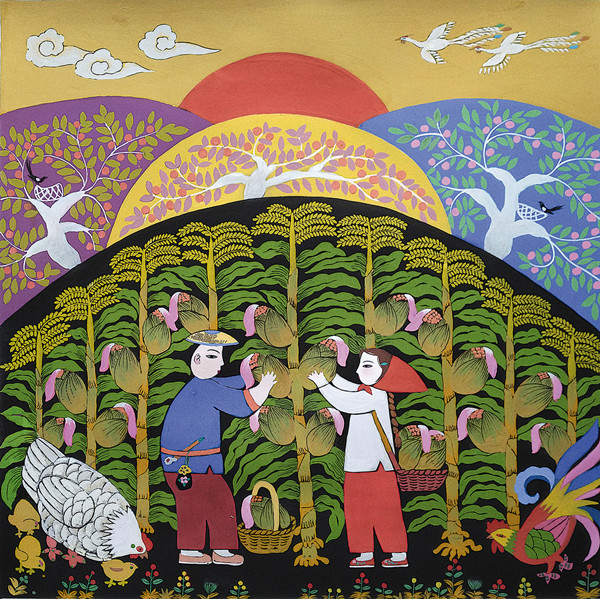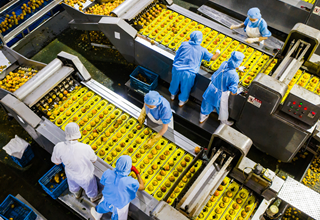Beichen sticks to its farmer painting roots

Tradition born in the 1950s remains strong in Tianjin
Nongminhua, or farmer painting, a popular school of painting developed by Chinese farmers, has been thriving in northern Tianjin's Beichen district since the late 1970s, and numerous training courses and activities have flourished there in recent decades.
To mark the 100th anniversary of the founding of the Communist Party of China on July 1, 100 top works painted by local residents were exhibited at the Beichen Cultural Palace. They were selected from more than 200 pieces submitted by enthusiastic artists.
Some primary schools, including Shuangkou and Lizui, have included farmer painting courses into their art curriculum and offer tailor-made teaching materials to help students appreciate and continue the art form.
"Beichen has devoted great effort, including human resources and funds, to supporting the art form's sustainable development," said Liao Kaiming, a writer on folk art and former director of the National Art Museum of China's Folk Art Department.
Exhibitions of works by students have often been featured on major TV programs, including on China Central Television, and in newspapers. Last October, Beichen asked the district's leading artists to create new farmer painting works inspired by its urban scenery and held seminars on the art form.
Until the pandemic, biennial competitions and exhibitions were regularly organized by the Beichen Culture Palace, attracting artists and fans from across the country.
The kind of effort is rarely seen any more in other national-level folk art towns, nominated by the Ministry of Culture in the 1980s, when the popularity of the genre was at its peak.
While folk art is fading elsewhere, its momentum in Beichen is rising, and awareness and appreciation of nongminhua has spread from farmers to primary school students, police, and community workers.
"The paintings are rooted in real life, a straightforward expression of the artists' hearty feelings, their outlook and perspectives, using skills that can be mastered without much difficulty," said He Xiaobao, associate researcher at the Beichen Culture Palace and a renowned farmer painting creator.
The art form became popular in the late 1950s and developed a solid foundation with grassroots farmers because it didn't require specialized abilities, and its use of striking colors was popular with rural communities.
"In addition, compared to traditional Chinese painting, nongminhua contains no strong connotations. Farmers who are fond of paper-cutting and embroidery can integrate those skills into their paintings, making it even more popular," He said.
The 36-year-old, who was previously a painter of traditional Chinese paintings, also said that in the 1980s, nongminhua works were frequently purchased by foreign embassies.
"Maybe because Beichen is near Beijing, many foreign diplomats purchased our paintings," he said.
To date, nongminhua exhibitions have been held in Sweden, Norway, the United States, South Korea and Italy.
More than 100 pieces are on display in museums abroad, and more than 10,000 pieces were sold to galleries or individuals outside China.
Zhang Weimin, 58, a nongminhua painter and a key inheritor of the school, as well as a former researcher at the Beichen Cultural Palace, said that collectors are mainly foreigners, some of whom sent the paintings home as gifts.
Zhang was famous for promoting the school at grassroots communities at home and abroad.
He Xiaobao added that Westerners have a taste for nongminhua because it resembles Naive Art, the work of artists who lack or reject conventional expertise in the representation or depiction of real objects, and that some commentators have touted the paintings as the work of "Asian Picassos".
"After the pandemic, I hope to boost its presence overseas, to better tell Chinese stories to the world," He said.
Yang Jian, deputy curator of the Beichen Cultural Palace, said: "We have supported nongminhua for decades. The palace will continue to support the art form's effort to become registered as a national intangible cultural heritage, and find different ways of increasing its influence."
For Tian Hao, a professor at Tianjin Normal University and a leading researcher on folk art, this support is critical, for he believes that the future for farmer painting may not be predictable.
"Nongminhua artists lack confidence and the market has shrunk in recent years. I expect more financial support from the government to invest in the art creation," he said.

Copyright © Tianjin Municipal Government.
All rights reserved. Presented by China Daily.
京ICP备13028878号-35



